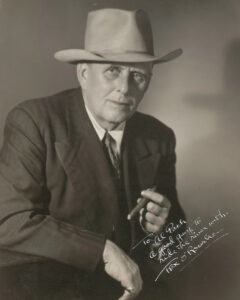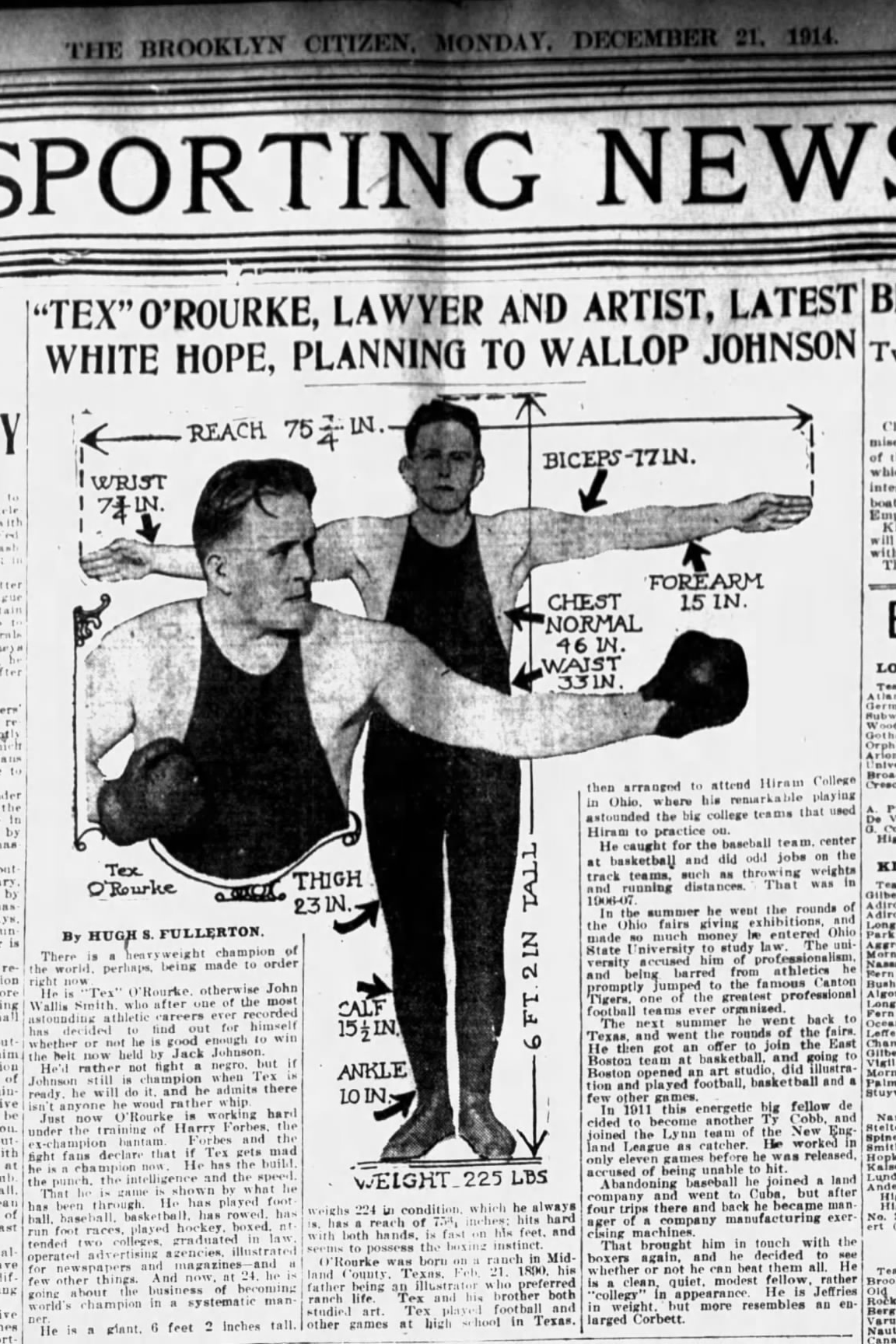 Tex O’Rourke (1886-1963) was a colorful figure in the world of boxing and publicity, a raconteur of The Lambs who boasted he met P.T. Barnum and grew up in the circus. O’Rourke was one of the original fabulists, a man who got one over on the New York Times, which printed a wildly outlandish obituary in the pre-Internet days.
Tex O’Rourke (1886-1963) was a colorful figure in the world of boxing and publicity, a raconteur of The Lambs who boasted he met P.T. Barnum and grew up in the circus. O’Rourke was one of the original fabulists, a man who got one over on the New York Times, which printed a wildly outlandish obituary in the pre-Internet days.
Among his many claims to fame, O’Rourke trained Jess Willard for his heavyweight championship fight with Jack Johnson in Havana on April 5, 1915 (that one is true). Willard knocked down Johnson in 26 rounds. A columnist called him, “One of those fabulous characters whose lives sounds like an incredible movie script.” In the 1950s, O’Rourke could be found most days in the Lambs’ grill room, holding court as a supreme raconteur, spinning yarns.
O’Rourke boasted he had been a Texas Ranger (untrue), attorney, boxer, cartoonist, lecturer, painter, radio broadcaster, semi-pro ballplayer, soldier of fortune (false), sports promoter, trainer, and Wild West show performer (highly unlikely).
John Wallis Smith was born July 10, 1886, in Columbus, Indiana, according to his census forms and draft registrations for WWI and WWII. At six feet, two inches tall, he grew up playing every sport. He claimed to newspaper columnists his father, John Wallis, was a U.S. Marshal and his mother, a circus equestrian (untrue). One of his biggest whoppers is that after his father left the family, he dropped his surname and traveled around circuses with his mother; he met P.T. Barnum as a lad. John Wesley Hardin, the Texas outlaw, gave him shooting lessons. As a boy he met Wyatt Earp and Bronco “Billy” Anderson. Billy the Kid’s killer, Pat Garrett, lived with his family (false).
He said at ten he was “adopted” by Company D of the Texas Rangers who taught the boy to ride and shoot; in actuality he was in school in the Midwest. He told reporters for years that he served as a Texas Rangers cook, broke horses at 14, and earned his star at 16. What he was really doing was traveling to county fairs with his mother, picking up cash in weight lifting and boxing matches. He was paid to play baseball and basketball, and went to the east coast for the first time as a teen.
He fought 16 professional fights but his ring career ended when a piece of spring from an exercise machine struck him and caused temporary blindness in one eye. He was also associated with Tex Rickard, later founder of the New York Rangers hockey team, in boxing promotions. This is where he likely picked up his nickname around 1913.
Among his claims, O’Rourke bragged that he went to Central America in 1908 and joined other American soldiers of fortune in fighting for any revolution that happened along. Upon returning to the U.S., O’Rourke got together a traveling sharpshooter act with Bat Masterson as his manager. He played Madison Square Garden with Buffalo Bill’s Wild West Show. He didn’t serve in World War I and worked in sales to support his mother and wife. He was a student at Ohio State, and possibly earned a law degree there. He got into boxing promoting before World War I after his own fighting career ended when he was 25. O’Rourke became a weekly staple of national sports pages by 1915, generating hundreds of headlines a year.

In the 1920s he was a founder and secretary of the National Boxing Association (today the World Box Association) and in the ‘30s he was MC of The Magic Key of RCA radio program on NBC Radio. An amateur painter, his subjects included outdoors scenes of hunting dogs. O’Rourke said he learned to paint in Boston at the Eric Pape School of Art in Boston.
O’Rourke traveled to Europe and Scandinavia looking for fighters to promote, and said he went around the world three or four times. He was married at least once; his wife, Elsie, was an English immigrant.
He was elected to the Lambs in 1940 as a Life member. He was president of the Adventurers’ Club and early member of the Circus Saints & Sinners, a non-profit charitable organization that he served as “executioner.” He was a toastmaster and in demand after dinner speaker for many years. Among those he roasted were Winston Churchill, Salvador Dali, a young Frank Sinatra, and President Harry Truman.
O’Rourke, at 6-foot, 2-inches, and weighed about 200 pounds, was fond of telling how he trimmed Willard down from 287 to 247 pounds for the 1915 fight. “When I finished with him, his face was pickled in brine and baked in the sun until it bore a peculiar resemblance to the inside of a catcher’s mitt,” he would say. “It was to be a 45-round fight, but two days beforehand we made Jess go 50 rounds, just to make sure.”
In the 1950s he worked part-time for Mack, promoting the company line of trucks. O’Rourke retired to Jackson Heights, Queens. He died May 13, 1963, following surgery at Polyclinic Hospital. He was 76 years old.
In the clubhouse of The Lambs is a 1964 lifesize bust of O’Rourke, by sculptor Donald Richard Miller, of nickel and bronze. It’s provenance and origin is unknown.
–Researched and written by Kevin C. Fitzpatrick, Club Historian.